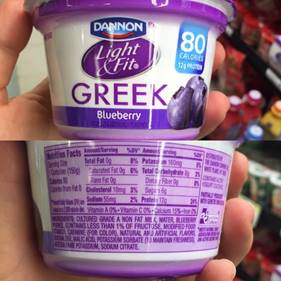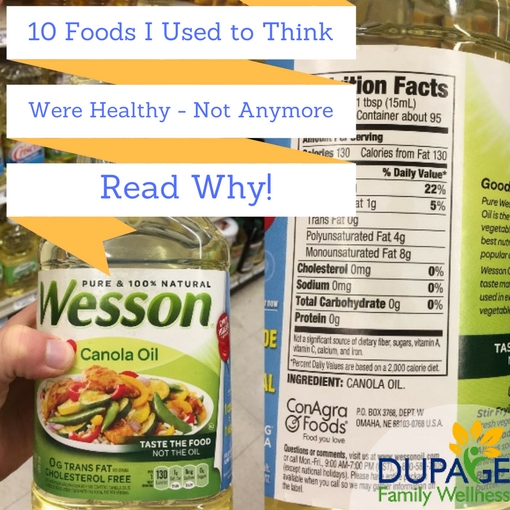
I used to be a calorie counter. I figured if I ate less calories than I burned, I’d lose weight! When it didn’t work, I was confused.
Many seminars later, I now understand that our food is MUCH more than just a source of calories! Our bodies are not simple scales, balancing calories in and calories out. Rather, the body has many complex chemical systems that break down the food we eat and process each ingredient in a different way!
I took a walk down memory lane at the grocery store yesterday, taking photos of foods I used to buy because I thought they were healthy. Keep reading to see these photos, along with the reasons that I no longer buy them. Note that my concern is with the entire categories or types of food, and I am not trying to single out the particular brand pictured.
Food Marketing Is Tricky
An important point to keep in mind is that food marketers can be really tricky. The food marketers do a fantastic job of making foods look and sound healthy to the consumer. They throw in buzz words like “gluten free”, “low fat”, “heart healthy”, “all natural”, etc. to make us believe the foods are good for us. What do these words really mean? I’ll point out examples as I go!
Also realize that their bottom line is the main concern of companies that make these products. What helps their bottom line?
- Making the food as cheaply as possible.
- Making the food's shelf life as long as possible.
- Making the food addictive so we want to keep eating it and buying it. They test combinations of sugar, salt, fat, and chemicals that taste good, AND keep up coming back for more.
These corporate motivations are NOT in our best interest! I don’t want the cheapest ingredients in my body. I want my food to go bad! This sounds weird, but if it will last on a shelf forever without bacteria consuming it, it must be full of chemicals to keep the bacteria away. Why should I eat it? Finally, I don’t want to be addicted to my food. Everyone knows that it’s hard to eat just one chip or cookie, but you don’t notice the same addictive behavior when it comes to broccoli or an apple!
Let's get started with the foods. They are in no particular order. It's hard to read the labels. To see them better, click on the picture, and a bigger image will pop up in a new window on your computer.
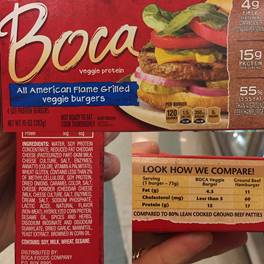 1. Boca Burgers and Veggie Burgers
1. Boca Burgers and Veggie Burgers
I thought that eating red meat was bad for me. I saw the comparison on the label showing that these soy patties have less fat and less cholesterol than a beef burger, and I was sold! Now I realize that I am not afraid of fat, and I know that cholesterol in my diet does not play a strong role in determining my body’s cholesterol levels. I now look at that ingredient list and it makes me want to run for the hills! I know the print is tiny, but I just counted 32 ingredients! My rule is: "If I wouldn’t want to eat the ingredients plain, then why would I eat them all combined in a food-like product". A good grass-fed burger, on the other hand, from a cow that was healthy and got to walk around and eat its natural diet while it was alive has one ingredient: beef! It has important nutrients, and I’d choose that any day!
2. Fruit flavored yogurt
I used to eat this every morning. I loved that it was only 80 calories. Now I look at it and see that it is “naturally and artificially flavored”. What does that mean? I don’t consume much dairy now, but when I do eat yogurt, I will get PLAIN, FULL FAT yogurt. When the milk came out of the cow- it had fat in it, and I’d prefer to keep it that way. The less processed the better. The fat is actually HELPFUL in keeping your blood sugar stable for longer periods of time without spiking. If I want a fruit flavor, I’ll add my own real berries!
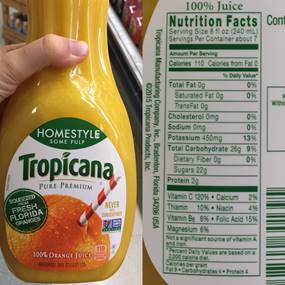 3. Orange Juice
3. Orange Juice
Ask my family, and you will learn that orange juice was my go to beverage growing up. Why not? Who doesn’t love a good 26 grams of carbohydrates to start their day! Unless you are SUPER active, most people will gain weight and start to have blood sugar control issues if they have over 150 grams of carbs in a day. With this glass of OJ, you are already 17% there, not including the 30+ grams you might eat in the cereal, bagel, or toast that you could be having alongside your morning OJ. A typical orange has 11 grams of carbohydrates. Also notice that the dietary fiber is 0. Even this “Homestyle”, and “fresh squeezed” orange juice doesn’t have any fiber. What about eating an orange? All of the membranes between the segments are fiber! That will fill you up and keep you much more satisfied than the sugar when you just have the juice itself. These statements are true for all juices, so keep this in mind for apple, cranberry, or your juice of choice.
 4. Whole Grain or Wheat Bread
4. Whole Grain or Wheat Bread
I started to pick up on the fact that white bread might not be my best option, so I switched to wheat or whole grain. More recently, I learned that the way bread is made now is VERY different from traditional methods of making bread. Previously, grains were slowly soaked and sprouted, making them easy for our bodies to digest. Companies that make bread in bulk have found cheaper and quicker methods to make bread. Unfortunately current practices for making commercial bread wreak havoc on our digestive systems and lead to inflammation! Look at that ingredient list. Traditional bread has flour, water, yeast, salt, and maybe a sweetener or herbs depending on the type. This ingredient list is huge with all sorts of ingredients breaking the rule of “simple things that I’d like to put into my body.”
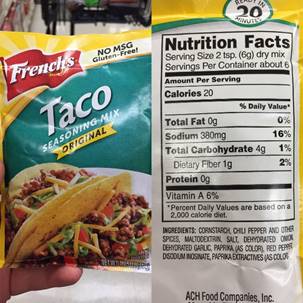 5. Seasoning Packets
5. Seasoning Packets
These were a convenience for me. I made tacos, and used taco seasoning. I made fajitas, and used fajita seasoning. That is, until I read the ingredients! Corn Starch? Why is the first ingredient corn starch? I have learned that making your own seasoning blends is easy, cheap, and delicious without any of the additives. Many of these packets have MSG and Gluten (if you see the word “natural flavors” that likely means gluten). This one doesn’t have MSG, but I don’t need maltodextrin or disodium isonate in my tacos! Here is a quick recipe for a good taco/fajita seasoning blend. I make this and keep it by my other spices to use for that very purpose!
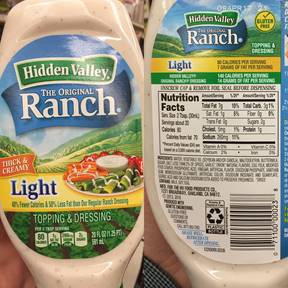 6. Salad Dressing
6. Salad Dressing
This is another one where the food marketers got me. It says light, it says gluten free, only 80 calories, so it must be good, right? In addition to the lengthy ingredient list, I do not like this dressing, or most store bought and restaurant dressings, because of the oils they contain. Over the past 5 years, I have learned how important fat is, but it is the “good fatty acids” that we need. Those found in real food sources like coconuts, olives, avocados, fish, meat, etc. When fatty acids are processed at high temperatures or high pressures, it makes them either unrecognizable or inflammatory to our bodies. Keep reading more about this in Canola Oil below.
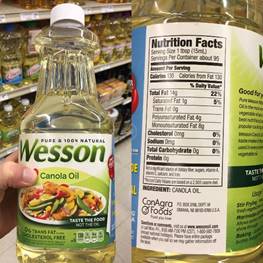 7. Canola Oil, Vegetable Oil and Margarine
7. Canola Oil, Vegetable Oil and Margarine
I was told that these were good for you. My thumb is accidentally covering it in the picture, but it says “heart healthy” right on the label. I have learned that this couldn’t be further from the truth. These highly processed oils did not exist until the early 1900s. Since then, they have skyrocketed and are found in EVERYTHING (like salad dressing, bread, crackers, chips, baked goods, etc.)! Why not? They are cheap, and have a very long shelf life. What is this doing to our bodies though!? This video explains how these oils lead to all sorts of inflammatory diseases that we think of as commonplace (even Heart Disease and cancer!). I avoid these like the plague. Instead, I cook with coconut oil, or animal fats like ghee and lard! I use olive oil to make my own salad dressings.
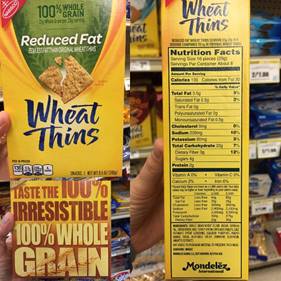 8. Wheat Thins, Pretzels and Crackers
8. Wheat Thins, Pretzels and Crackers
The old me saw the “reduced fat” and the “whole grain” and I was sold. Since then I have learned a few things.
1) There are no nutrients found in a grain (whole or otherwise) that couldn’t be found in vegetables.
2) Look at all of those carbohydrates - 22 g! See Orange juice above in case you missed my rant about too many carbohydrates.
3) They contain those low quality oils that I discussed in the canola oil section above.
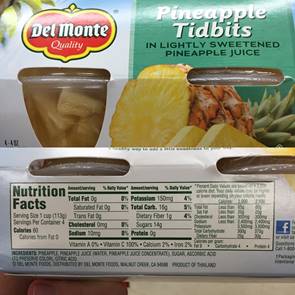 9. Prepackaged Fruit
9. Prepackaged Fruit
This one was another convenience purchase. I bought these sorts of packages to put in my lunches. I figured it's fruit, so it must be healthy. Well, yes it is fruit, but do you know many (including this one) have added sugar? Why would you add sugar to pineapple? It is already sweet. Now, if I want pineapple in my lunch, I cut my own pineapple (or other fruit) and put it in a container. Yes it is one extra step, but I believe it’s worth it to skip the sugar and added ingredients!
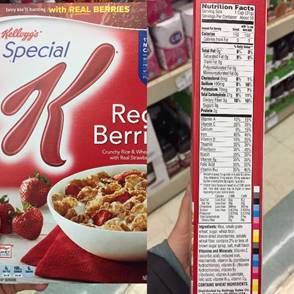 10. Cereal
10. Cereal
I used to buy special K every time I went to the store. There was a Special K Challenge: eat only Special K for a week or two to lose weight. Well I've learned a lot about this one. First of all, I believe that when you put only good nutrient dense REAL FOODS like fruits, vegetables, and meats into your body, it will naturally move toward your ideal weight. So what do I see now when I look at this package. Besides the high carbohydrates and long ingredient list, the first thing that pops out at me is the giant list of vitamins. Vitamins are good right? Well these vitamins would be what you call “fortified.” They are artificially added to the food during processing. Isn’t this a good thing you ask? Did you know that wheat flour by law, must be fortified with calcium, iron, and B-vitamins folic acid, thiamin, niacin, and riboflavin? Because of this, when you read a label of many grain based products (breads, pasta, cereals etc), it looks like they have a high quantity of nutrients. However, these are artificially added into the foods during processing, and are not in the natural forms or in ratios that mother nature had originally packaged them. According to this research article, there is some evidence that having TOO HIGH of doses of vitamins (from fortification or supplementation) is linked to obesity and diabetes. When it comes to vitamins, I believe that our best source are those naturally found in foods in their proper ratios and with proper co-factors for ideal absorption and utilization.
If Not These Foods, What Should You Eat?
If you made it this far, you may be wondering what I do eat if I won’t buy any of these things, check out this post to learn more!
I hope you learned something. While I enjoyed my little walk down memory lane, this in no way made me want to purchase any of these foods! I know how much better I feel since cutting them out of my life that that’s motivation enough not to go back!
Are there foods that you eat, but your are wondering about how healthy might be? Let's discuss on facebook.


